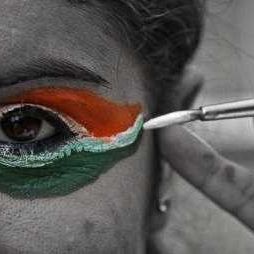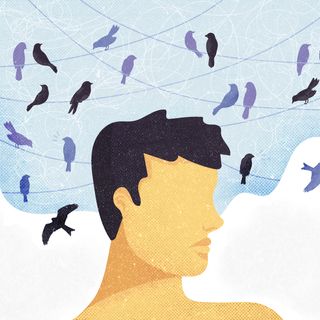
Women Are Hypervigilant About Safety. This Is the Toll It Takes.
An ongoing state of fight-or-flight can cause “physiological reactions similar to chronic stress,” a psychologist says.

Last month, a Twitter thread detailing a woman’s observation of a man who appeared to be in his late 30s sexually harassing a teenage girl during a flight went viral. Joanna Chiu, a Canadian journalist who was sitting in the row in front of them, had planned to get some sleep during an overnight flight, but “couldn’t avoid noticing what was going on in the row behind me.”
The man started by asking the teenage girl about what career she’d like to pursue, laughing when the girl replied she hoped to be a CEO, Chiu tweeted. The man soon became very familiar, Chiu recounted, teasing the girl and asking to take her out to eat, which the girl ignored. “At this point I had to stay awake in case anything went further than that,” Chiu tweeted.
Chiu monitored the conversation, and ultimately intervened when the man asked the young girl for a “dirty” photo. A woman seated in the row behind the girl had also been monitoring the situation and offered the girl support. The women got the attention of the flight crew, and with much resistance from the man, they eventually managed to force him to move seats.
“But none of the male passengers seemed to show they noticed what was going on. Maybe fellow women are more likely to pick up on warning signs early on in the conversation because we used to be teenage girls too?” Chiu tweeted, going on to recount her own experiences as a young girl travelling alone and the male passengers who had spoken to her inappropriately and forced a kiss on her without her consent.
From online discussions like these and others, mainstream society is slowly awakening to the fact that a majority of women move through the world in a constant, heightened state of awareness.
Sadia Saeed, a psychologist and founder of Inner Space Counseling in Mumbai, recounts the ways she has heard women talk about staying vigilant about their surroundings — paying attention to “whether we’re being watched or not, is it a dark space, what we’re wearing.” This sixth sense for danger was highlighted in another popular Twitter thread late last year, when a social researcher informally polled men and women to share what they do on a daily basis to avoid being sexually assaulted; all men replied with variations of “Nothing,” while women responded with hundreds of specific actions, small and large, that they take to keep themselves safe.
Related on The Swaddle:
#MeToo Is Making People Confront Their Trauma. And Most Are Unequipped To Do So.
But Saeed hesitates to qualify this state as hypervigilance, a clinical term that describes a state of increased sensory alertness. Hypervigilance, Saeed says, is “the body saying there is a threat in the environment, so, you have to be at your most alert self. You can’t be relaxed, because if you’re quiet or relaxed, then something bad can happen to you. The system is always sensing threat.” In fact, a hypervigilant person might perceive stressors as threatening when others simply view them as stressors. Hypervigilance is considered a symptom of post-traumatic stress disorder and has been documented in soldiers and natural disaster victims. It is also associated with anxiety and other mood or personality disorders.
In women, “conditioning already leads to vigilance,” she says. “If you add an incident that leaves a traumatic impact” then hypervigilance is probable, though not inevitable. “Different people process [trauma] differently,” she says, adding that a lack of coping mechanisms contributes to the development of hypervigilance after a traumatic experience. (She also notes hypervigilance isn’t always the effect of gendered trauma, and it can also affect men.)
“Trauma can take many forms,” she says. “It can manifest in many forms, too.”
One of those forms could be vicarious, she says, that is, an emotional reaction to others’ accounts of trauma that leaves a person anxious, angry and/or sad; in the midst of India’s wave of #MeToo reporting late last year, many of those involved in the movement reported exhaustion, depression, distress, panic attacks, hyper-stimulation and more, not necessarily from their own trauma (though in many cases, that, too) but from empathetic reactions to an onslaught of stories about abuse, harassment and rape.
These stories surround us; newspapers report brutal crimes against women almost every day. Even fiction provides no escape. In a recent op-ed for The Guardian, Hallie Rubenhold spotlights “our drive to use women’s brutalized bodies as a flimsy springboard to tell a story about a male killer.” She lists an overwhelming number of popular and upcoming shows that rely on abused, maimed and murdered women to frame the narrative — Netflix’s Conversations With a Killer: The Ted Bundy Tapes; Hollywood’s upcoming Extremely Wicked, Shockingly Evil and Vile, also about the serial killer; BBC One’s Jack the Ripper – The Case Reopened. Prestige television is awash with it, she argues: Luther. True Detective. The Killing. The Fall. Top of the Lake. It would be remiss not to add to that list India’s latest prestige drama, Delhi Crime, based on the gruesome and barbaric rape and murder of 2012’s Nirbhaya case.
Even for women removed from these (largely) digital movements and entertainment, vicarious trauma is possible; according to the last National Family Health Survey (NHFS-4), one in every three women in India experiences sexual or physical abuse at home, making it likely that most women know the true-life story of at least one woman who is the survivor of assault, if not more.
There are no reliable stats on hypervigilance in women, though it is well-known that anxiety disorders, which often accompany hypervigilance, are twice as common in women than men. There are only stories like Chiu’s, which anecdotally every woman can identify with, but no one has quantified. Without figures, however, it’s difficult to gauge the fallout. Hypervigilance, as an ongoing state of fight-or-flight, takes a physical toll. “There will be a lot of physiological reactions similar to chronic stress,” says Saeed. Digestion, sleep and endocrine function will be disrupted, she says. Chronic stress has also been linked to increased risk of cardiovascular disease and heart attack, and impaired fertility and sexual desire.
While the increased awareness of environmental threats most women describe may not always qualify clinically as hypervigilance, it’s difficult to rule out the possibility that this heightened alertness has similar effects. “It’s a spectrum,” Saeed says. “There’s no point at which you can say, ‘This is relaxed, and this is hyperawareness.'”
“We have mental stories about what is likely to happen to us. And we’re not aware of these stories, and we’re not aware of our bodily reactions [to them],” she says. Dealing with heightened alertness means becoming more aware of what your body is going through. “The bodily system has been wired to be alert; you can’t force it to shut down.
You have to rewire it to relax,” she says. Saeed advises in the moment of heightened response (not in moments of actual danger) grounding your feet and focusing on your breath. Over time, meditating can help if the feelings of increased awareness become overwhelming — until, of course, society stops giving women a reason to be hyper alert.
“A certain degree of increased vigilance comes with [gendered] conditioning,” Saeed says. “Conditioning has a big role to play in it.”
Liesl Goecker is The Swaddle's managing editor.
Related


Let’s Be Honest: ‘Consent Condoms’ Are a Marketing Ploy
